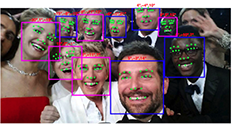News Story
UMD Inventors Develop Face, Gender, and Pose Detecting Algorithm

Sample results from HyperFace.
Spotting a face in the crowd can be tough enough, but what about finding a face from the innumerable collection of photos floating about on the Internet? A group of University of Maryland (UMD) researchers has developed an algorithm that could take on this daunting task through its capability to not only detect a face, but also simultaneously determine the gender, pose, and extract fiducial, or reference, points.
This invention, named "HyperFace," was created through a collaboration between UMD Minta Martin Professor and Chair of Electrical and Computer Engineering Rama Chellappa, UMD Research Assistant Rajeev Ranjan, and Assistant Research Scientist Vishal Patel (Ph.D. '10), who is now assistant professor of electrical and computer engineering at Rutgers University. The Office of the Director of National Intelligence (ODNI), Intelligence Advanced Research Projects Activity (IARPA) has provided funding and support for the project
"HyperFace is an algorithm that simultaneously detects faces, finds facial landmarks (including eye center, nose tip, etc.), estimates the head pose, and recognizes their gender from any real-world images and videos," said Dr. Chellappa.
The team's inspiration for this technology is deeply rooted in the brain's ability to analyze features, landmarks, and emotions of a human face all at once.
"Our brain is able to locate faces, facial parts, face pose as well as gender from one image. In a similar way, HyperFace trains a deep learning network to simultaneously perform these tasks and provide face-related information via an algorithm," said Dr. Chellappa.
While we are accustomed to some social media platforms being able to recognize and tag faces, this technology goes far beyond those capabilities, and the implications for the future are far-reaching.
"Its applications include automatic face tagging, mobile active authentication, automatic monitoring through surveillance cameras, face identification, affective computing, and expression analysis for medical applications, such as automatic pain and fatigue detection, facial emotion analysis, and many more."
The team envisions the technology will be used in multiple fields, particularly in medical, security, psychology, surveillance, and social networking applications.
“From the early diagnosis of autism to the identification of long-term missing children through aging modeling, this invention has the potential to make a significant impact on human lives,” said Dr. Chellappa.
UMD's Office of Technology Commercialization has nominated the invention for the Invention of the Year award in the Information Sciences category. Winners will be announced at the Celebration of Innovation and Partnerships on May 9th as part of the University of Maryland's "30 Days of EnTERPreneurship."
To learn more about the University of Maryland’s "30 Days of EnTERPreneurship," visit: http://www.umd.edu/30Days/.
Published April 27, 2016









